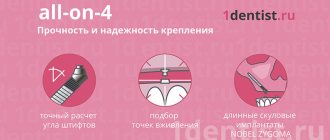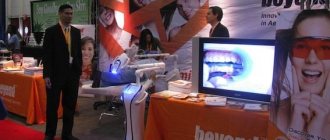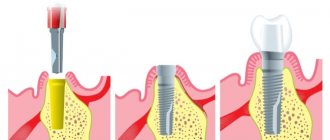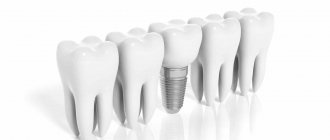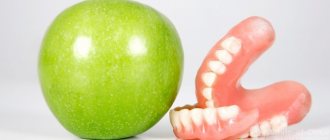The all on 4 method is implantation in the complete absence of teeth in the jaw, when a fixed bridge prosthesis is fixed to only 4 titanium supports. Prosthetics are performed no later than 72 hours after the implantation surgery, which allows patients to restore their teeth in record time.
The all on 4 technique is based on the unique properties of titanium. The metal is capable of merging with human bone tissue and forming a single, strong structure. The healing process is called osseointegration.
Nobel-Biocare, after further improvements to the titanium surface, achieved a uniquely rapid fusion of titanium and jaw bone tissue and in 1998 announced the all-on-4 protocol - “All on 4 implants”.
“All on four” implantation: fast and effective smile restoration
“All on four” is an independent treatment protocol that can be used to restore only a full row of teeth.
If a person is missing only a few teeth, then the method will not work. Or it is suitable if the teeth are sick and need to be removed. This concept has been actively used in dentistry for more than 20 years. The system was first used in 1998, when a specialist from Portugal, Paulo Malo, successfully used the All-on-41 technology during treatment. Important information! This method was developed by Nobel. The name of the protocol is registered and is a trademark.
What is the essence of technology
Dental prosthetics using All-on-4 technology involves placing two structures in the anterior section in a vertical position, as well as implanting two more in the lateral section at a certain angle. This depends on how severe the bone loss is and where various elements of the jaw structure, such as nerves or sinuses, are located.
This protocol provides a real opportunity to avoid bone tissue buildup in conditions of a slight decrease in its size in width or height. After all, inclined implantation allows you to fix them in denser layers of bone without affecting the maxillary sinuses.
On a note! This method involves the implantation of only four implants, which in some situations can seriously affect the final cost of treatment. Thanks to this protocol, implantation has become accessible to most patients.
Let's take a closer look at what it is. So, this is a one-stage implantation protocol, it is carried out on 4 implants and involves fixing the prosthesis on the same day or a couple of days after. At the same time, experts advise patients to gradually increase the load on new teeth. Thus, after a couple of weeks a person can return to a normal lifestyle.
“All on four” – used to restore only a full row of teeth.
An important feature of prosthetics is also that the design has a dense base - a metal clasp or beam on which the plastic gum is attached. Due to this, it is possible to achieve very high stabilization of the implants. After all, they literally connect to each other, so even after the chewing load falls on them, they do not move either vertically or horizontally.
Does the protocol have any disadvantages?
The all-on-4 concept is indicated only for cases of minor atrophy in the lateral parts of the jaw; in cases of pronounced bone loss, its use may be ineffective. In such a situation, it is possible to strengthen the primary stability of the entire system by simultaneously adding osteo-replacement chips, using zygomatic implants, if we are talking about the upper jaw, or consider concepts with an increased number of implants - all-on-6 and basal technology.
According to numerous reviews from doctors and patients, in Russia one-stage protocols are still a relative novelty, which is why it is not so easy to find a truly experienced and competent specialist who could carry out treatment at the proper level. The clinic must be equipped with advanced computer software for 3D visualization of each stage of treatment, and the doctor must be well versed in it. He is also required to undergo appropriate training, obtain all necessary certificates and permits in order to be able to apply one-step techniques in practice and work with premium brand products.
Advantages over the classical method, as well as disadvantages of the method
The treatment concept under consideration has many undeniable advantages. The main advantages of the technique are listed below:
- use for complete edentia: the All-on-4 dental prosthetic technology has proven itself to be excellent in restoring the entire dentition. In addition, the method is successfully used in cases where the deplorable condition of the remaining teeth requires their removal,
- quick smile restoration: these are teeth that can actually be obtained in just 1 day. The complete treatment process takes up to 4-5 days on average,
- the ability to achieve impeccable aesthetics: implants serve as supporting elements for the installation of modern orthopedic structures that meet high aesthetic standards,
- additional protection against aging: fixing the prosthesis immediately after implantation allows you to restore tone to the facial muscles and thereby prevent premature aging, which inevitably occurs when several or all teeth in a row are missing. It has been proven that after dental restoration, wrinkles are smoothed out,
- no need for bone augmentation: installation of the structure at an angle makes it possible to use a large area of bone material, so preliminary bone augmentation, as a rule, is not required, or is carried out simultaneously with implantation,
- excellent stability indicators: the use of deep and denser bone sections, as well as the use of elongated zygomatic implant models for the upper jaw, guarantees high primary stability,
- restoration of the condition of bone tissue: almost simultaneous installation of implants and prostheses makes it possible to stop the rapid reduction in bone tissue volume, which is a natural consequence of tooth loss and entails uneven distribution of the load,
- the most accurate placement of implants: thanks to computer modeling and the use of special templates, it is possible to significantly reduce the risk of making mistakes during the operation.
Using computer modeling, it is possible to calculate the most accurate placement of implants
. Despite the impressive list of advantages, the use of this protocol is possible only if there is a slight loss of bone volume. The fact is that if there is an acute shortage of it, such a number of implants will not be enough to securely fix the prosthesis. Otherwise, after a fairly short period of time, the entire system will lose its functionality under the influence of increased loads. For this reason, in case of acute bone tissue deficiency, it is still worth paying attention to alternative solutions to the problem. For example, for a protocol on six dental implants or basal implantation in general, where the number of supports is increased to 120-12 pieces per row.
Features and benefits of the technology
- the optimal solution for complete restoration of the jaw – one or both at once,
- quick results - treatment takes no more than a week,
- high aesthetics of the final result - the prosthesis is equipped with acrylic gum, designed to hide defects in the edge of the mucous membrane. The adaptive design has lightweight plastic or ceramic-composite crowns - the latter are more reliable and durable and do not require re-prosthetics. After osseointegration of the titanium roots (after six months or a year), it is possible to install a stronger and more durable prosthesis, and even replace the material of the crowns - for example, with ceramic composite or zirconium dioxide. However, you can also use inexpensive plastic, but the service life will be shorter,
- refusal to build up atrophied areas of bone - inclined installation of lateral implants or the use of zygomatic models allows treatment in conditions of bone tissue atrophy without the need for its preliminary build-up. If resorption is very pronounced in the upper jaw, standard lateral implants are replaced with zygomatic ones, and they are attached to denser and sterile parts of the cranial bone, namely, in the zygomatic bone, as the name implies,
- rapid tissue restoration - occurs due to the compression effect, that is, compaction of the thickness of the bone tissue at the time of screwing in the implant (with a minimally invasive method of installing structures). In any case, the immediate installation of a prosthetic structure allows you to quickly normalize nutrition, restore chewing function, and provide the necessary load to activate metabolic processes in atrophied areas of the bone. All this contributes to faster and better engraftment of artificial roots. In addition, the stabilizing beam under the prosthesis connects the implants together and does not allow them to move,
- the possibility of minimally invasive installation - the use of special surgical templates made it possible to carry out such operations not in a flap, but in a less traumatic way. An elastic stencil with slits for the implantation sites is placed on the gum, after which punctures are formed in the mucosa and bone, through which the rods are screwed into the bone. Surgical templates are developed using computer simulation, which minimizes any risk of deviation from the norm,
- possibility of adjusting the prosthesis - the orthopedic device is fixed with a screw. This means that the structure is attached using small screws that pass through the chewing surface of the teeth. Therefore, the prosthesis can always be removed for relining, but this can only be done by the attending physician,
- choice of prosthetic options - immediately after implantation, a simple prosthesis on a metal beam and with plastic crowns can be installed. There is also the option of installing a more expensive, but reliable and high-quality structure with ceramic composite crowns and an individual titanium beam,
- rejuvenation effect - the prosthesis is fixed immediately, which contributes to the rapid restoration of the chewing and facial muscles, returns them to tone and helps fight wrinkles around the mouth, which often appear due to missing teeth.
Main indications and contraindications
The main indications for the use of this protocol include the following conditions:
- complete absence of teeth in a row,
- loss of a large number of teeth, and the remaining ones must be removed due to poor condition,
- sufficient volume or minor resorption of the jawbone,
- the patient’s desire to receive treatment results within a few days without returning to removable dentures.
Complete absence of teeth is an indication for implantation.
Like any implantation method, this technology is characterized by its pros and cons. For example, the technique has its contraindications - it is not used for severe atrophy of the jaw bone, as we noted earlier. The fact is that even an inclined installation of the structure in this case will not be able to ensure reliable fixation of the implant.
New standard of implantation – minimal invasiveness
The world does not stand still; new research is constantly being conducted in the field of dental implantation. Long-term 10- and 20-year observations of implants functioning successfully in the oral cavity are appearing. Clinical studies show that the thickness and length of the titanium rod are not the main factor in success. Implants of large diameter and length often lead to complications and their lifespan is sometimes shorter. This is due, first of all, to the more traumatic installation of “thick” models.
An important factor in the long-term functioning of artificial roots is the preservation of the patient's own bone through the use of thinner and shorter implants. This also reduces the need for bone grafting because Initially, less bone tissue is needed to completely immerse a thin implant into the bone.
However, thin models from not all manufacturers are able to withstand heavy loads in the area of chewing teeth, or in the absence of teeth. These requirements are met by German Ankylos implants
, as well as Swiss Straumann Roxolid implants.
Ankylos implants have design features that, when installed below the level of bone tissue, allow them to withstand heavy loads even with their small diameter. Roxolid is an alloy of titanium and zirconium, which was developed by Straumann. It is much stronger than just titanium and has the same biocompatibility. Therefore, thin Straumann Roxolid implants can be used in cases where it is necessary to install a larger titanium pin from another manufacturer.
- Minimal invasiveness.
- No bone grafting required.
- Guaranteed results even in complex clinical cases.
Preparation for implantation using All-on-4 technology
Before the procedure, evaluation of the results of computed tomography is mandatory. If you plan to implant zygomatic implants (and they can be either two or all four supports on the upper jaw), then you will also have to undergo multislice tomography - it is more accurate and in-depth in terms of assessing all facial tissues. It is definitely better to undergo such an X-ray examination in a specialized diagnostic center that has modern high-precision equipment. Unfortunately, with the equipment in dental clinics, it is not possible to achieve the required degree of detail in the images - here you can limit yourself to only classical computed tomography (CT).
The photo shows a tomography being performed
If you have health problems, you also need to take blood tests. More precisely, the doctor should take them in any case, but the decision on further examinations is made based on an assessment of the results - it is quite possible that you will additionally have to visit an otorhinolaryngologist (ENT doctor), endocrinologist, cardiologist, oncologist, or simply start with a general practitioner.
One of the mandatory conditions for using All-on-4 is also computer modeling of each individual stage of treatment. The data obtained during the X-ray examination is transferred to a special computer program, with the help of which a thorough assessment of the quality and condition of the bone tissue is then carried out, and the selection of suitable models of implants and points for their implantation is carried out. Preparation also involves eliminating all pathological processes in the oral cavity, removing plaque, supra- and subgingival deposits.
The simulated stencil will ensure accurate installation of implants
In general, each clinic uses its own software - 3D modeling software. But if we take into account that the protocol is a development of the Nobel company, then it is advisable to use programs from this company. Thus, a Swiss company has developed software called NobelClinician, which allows you to work out the process of virtual installation of implants of this brand as accurately as possible. However, it is not prohibited to use other software, although the accuracy may be lower.
Alternatives
Basal implantation
Basal Complex is a technique for replacing a lost row of teeth with severe atrophy of the jaw bone. The protocol provides for a combination of 8-12 implants (compression, basal), some of which are implanted not into the central region of the cancellous bone, but more deeply into the basal, bicortical sections. They are highly dense and do not undergo resorption or inflammation. The ability to install artificial roots bypassing important jaw structures minimizes the risk of complications.
One-piece basal models have a special design and are equipped with active threads. They pass through the cancellous bone, the bicortical plate and are fixed in the basal bone. This ensures their secure fixation
and
high initial stability
. A large number of supports allows you to immediately install a complete fixed denture on 4 implants, which evenly loads the entire jaw.
The main advantage of the method is the ability to perform implantation in patients with critical jaw bone deficiency in 95% of situations.
This is the only technology that is recommended for patients with a complicated medical history (severe periodontal disease, critical atrophy of bone tissue, diabetes, HIV, hepatitis, etc.). Removable dentures: disadvantages of the method
Removable dentures are a very economical method of replacing teeth. But this price is due to many inconveniences when using it.
The use of a complete removable denture for a toothless jaw leads to the fact that the load during chewing is transferred directly to the alveolar process. This provokes accelerated bone atrophy with recession (subsidence) of the gums. This can lead to the fact that the orthopedic product has to be repositioned approximately every 2-2.5 years
. Due to subsidence of the mucous membrane, the structure no longer fits tightly to the gum, does not stay in the mouth, injures soft tissues, and quickly breaks.
The second problem with removable prosthetics is the initially insufficient fixation of the structure in the mouth. If the product is still “sucked” relatively reliably to the maxillary tissues, then in the lower jaw it is impossible to achieve such an effect unless mini-implants are first installed under the prosthesis.
ROOTT clinic specialists will help even in very difficult clinical cases using the latest smile restoration technologies. Contact us for a free consultation from qualified specialists.
All-on-4 implantation technology – stages of the operation
On average, simultaneous implantation using this system requires 3-4 days. In some situations, treatment takes a little longer, which is usually due to the need for preliminary preparation or more thorough diagnostics:
- At the first appointment, the doctor conducts a visual examination, prescribes the necessary diagnostic procedures, which usually include an orthopantomogram and computed tomography,
- The specialist enters the obtained data into a special computer program, which is used to select the optimal type of implants and type of prosthesis. In the same program, a virtual trial fixation of the selected design is carried out. Thus, the treatment is completely predicted using modern technologies, which eliminates any risk of error on the part of the implantologist,
- During the second visit, the doctor installs the implants under local anesthesia. The procedure takes on average 2-3 hours. In a number of situations, general anesthesia may be used if the patient has a pathological fear of such an operation. You can also consider sedation - intravenous or inhalation, which is easier to tolerate than anesthesia, and at the same time has a minimum of contraindications,
- During implantation or a few days after it, the prosthesis is installed. Several days are usually given for the gum tissue to recover and for the specialist to evaluate the results of the procedure and the reliability of the primary fixation.
The photo shows prosthetics on 4 implants
What types of implants are used?
If we talk specifically about the all-on-4 protocol, then in this case the implants of the developer brand will be used. Models are selected individually, taking into account the characteristics of each specific case. The concept involves the implantation of two-part structures with multi-unit abutments: the NobelParallel model for fixation in a straight position, the NobelSpeedy for an inclined implantation and the Nobel Zygoma for the zygomatic bone.
It is important to note that Nobel products belong to the premium segment and are quite expensive. But prosthetics on 4 implants can be carried out using systems from other, more affordable brands. So, for example, the total cost of restoration can be somewhat reduced if we take the products of the South Korean company Osstem as a basis - in principle, while maintaining guarantees of quality and durability of the result. These implants are also of high quality, which are complete analogues of leading brands and, in general, are also designed for immediate loading (although they have certain restrictions for installation compared to Nobel).
Straumann also presented its version of the all-on-4 protocol at one time. The concept was called Pro Arch and, in fact, became a direct alternative to the technique previously patented by Nobel. The only key difference is that in both cases the use of implants from the company that developed the protocol is assumed. It should be noted that the Straumann concept also allows for the installation of special shortened models, which allows it to be used in the presence of more pronounced signs of atrophy without adding long zygomatic implants to the complex.
Features of choosing implants
To carry out implantation using the four-way system, products (Nobel), which developed this method, are most often used. Moreover, in each individual case, implants are selected individually for each patient. According to reviews from patients and specialists, Zygoma models are often added to the complex. These are elongated structures that are used during the development of atrophic processes in the upper jaw. The special shape makes it possible to minimize the risk of injury to the maxillary sinus. They are fixed in the zygomatic bone.
Zygoma implants are fixed in the cheekbones
On a note! This manufacturer produces quite expensive, but high-quality products. You can save a little on treatment by giving preference to implants from other, more budget-friendly, but no less reliable brands, for example Alpha Dent (Germany) or Osstem (South Korea). True, here you still have to give up the immediate load, that is, agree to wear a removable denture for at least six months without support from implants, because structures are simply not provided to withstand the load from the prosthesis. Of course, the doctor may insist otherwise - but be careful: even if nothing happens right away, after a few years the implants may simply fail. That is, the savings will, on the contrary, result in increased costs for you to redo the entire operation.
Dentist-Orthopedist
| Danis Raisovich Moginov Work experience: More than 17 years Doctor of the highest category Special Skills: All types of orthopedic work Sign up for a consultation |
For more information and to make an appointment with a specialist, call:
+7,
or use the feedback form Sign up for a consultation and we will call you.
What types of prostheses are used when implanting All-on-4
The treatment concept under consideration allows the prosthesis to be installed directly on the day of implantation. In this case, artificial teeth are created in advance, since the models are selected using a computer program as part of planning the entire treatment process. In addition, sometimes it is also possible to reline an existing removable structure. While the implants are taking root, the patient is fitted with plastic-acrylic permanent solutions. This is the first option. But it is important to understand that since the structure is relatively removable and there is no splinting effect, it is worth significantly reducing the chewing load for the first six months, otherwise, due to increased pressure, the implants will take root poorly.
The second option is the installation of permanent bridges. They have a metal base - a dense arc that connects and splints the installed implants. Just like a bridge in reality - there are supports and there is an upper part. Due to this, the structure can withstand the load and functions immediately. When choosing such a system, you can eat almost immediately - at least as soon as the discomfort associated with surgical intervention passes. Dentures are installed using screw fastening. If Nobel implants are chosen, then this is a completely safe system.
Types of fastening for all-on-4 implantation
Basically, clinics offer a classic, inexpensive option made from acrylic and plastic. Such a prosthesis must be worn for the entire time the implants take root, and no longer than 3 years, because otherwise the crowns will wear down. Due to this, the height of the prosthesis will decrease and the bite will be disrupted. Another modern option is plastic at the base and crowns made of ceramic composite. This option is almost 2 times more expensive, but it can be installed immediately and for at least 15-20 years. That is, there is no need to change.
“I personally tried this technique on myself. In my opinion, an excellent solution for instant dental restoration! To be honest, at first after the operation I experienced some discomfort, but after a couple of weeks everything went away and my diction was completely restored. Now the result completely satisfies me. It seems to me that the main thing here is to carefully consider the choice of clinic and doctor, since the method is relatively new, and I, for example, would not take risks and trust my teeth to a young and inexperienced specialist.”
Eugeniy, 46 years old, from correspondence on the forum
After complete implantation of the implants, which usually takes about a year, the patient chooses one of the possible ways of further development: continue to walk with the installed prosthesis until it breaks or fails (but no more than 3 years), or install a more reliable permanent structure. If finances allow, then you can choose more aesthetic and durable ceramic composite, pure ceramics or zirconium dioxide instead of plastic - it depends purely on your capabilities.
Implants for 4: what the prosthesis looks like - materials
In the photo, the dentures on 4 implants look different. Some are natural, like real teeth, others are simpler. Main materials used in prosthetics:
- metal ceramics;
- zirconium dioxide;
- ceramic composite.
What are the global differences between artificial jaws made of different materials - pros and cons, characteristics.
Metal ceramics for all-on-4 prosthetics
Metal-ceramics is familiar to everyone who has ever thought about inserting a tooth on a turnkey basis.
This is the most inexpensive and aesthetic material in orthopedic dentistry. It is chosen for single prosthetics with crowns and for the manufacture of a full-fledged artificial jaw. Advantages of metal ceramics for all-on-4 prosthesis:
- Excellent physical and mechanical properties.
Cobalt chromium alloy is used as a metal component. It is characterized by high resistance to deformation, strength, and reliability. - Quite a long service life
- dentures made of metal ceramics last up to 10 years. - Affordable cost
- in comparison with zirconium crowns, the cost of the orthopedic stage will be 1.5-2 times lower.
Metal-ceramics also have disadvantages:
- risk of developing allergic or galvanic reactions;
- slightly unnatural appearance, poor aesthetics;
- If repairs are necessary, the entire prosthesis must be removed for restoration in the laboratory.
Zirconium metal-free permanent all on 4 design
Metal-free orthopedic structures are indistinguishable from real teeth.
They not only reliably imitate crowns and enamel, but also form an ideal gum contour for “all-on-4” prosthetics. Advantages of zirconium products:
- Aesthetics and believability
. No one will be able to distinguish artificial zirconium teeth from real ones. - Mechanical strength
. Higher than that of metal-ceramic prostheses, which guarantees the reliability and integrity of the system when worn. - Biocompatibility with human tissues
. The material does not cause allergic reactions or gum irritation. Due to the absence of metal in the crowns, the risk of galvanization is eliminated. - Durability of wearing
. Zirconium dioxide is inert to food dyes and odors, does not deform or collapse, and lasts for decades without repair or replacement.
Disadvantages of the all-on-4 zirconia prosthesis:
- High price.
All on 4 prosthesis: photos and features of ceramic composite
Ceramic-composite dentures are used quite often for all-on-4 implantation.
The reasons are simple:
- Ideal aesthetics of real teeth
. Layer-by-layer application of polymer during the manufacture of a prosthesis ensures the natural color of the enamel and natural light transmission. - Resistant to food coloring
. There is no need for even the slightest restrictions after installing teeth using the “all on 4” protocol. - Strength, reliability
. Ceramic composite has a low level of wear. - Convenient, quick repair without removing dentures
. Any chip can be easily restored using ceramic composite material.
Flaws:
- The high price of a titanium-based prosthesis - especially if premium segment implants are chosen for all-on-4.
- Careful daily care - good oral hygiene using a irrigator to eliminate the risk of plaque forming from inside the crowns.
Do dentures require special care?
Any orthopedic structure in the oral cavity requires special care and attention. By ensuring the proper level of hygiene, you can significantly extend the life of the product. The structures installed after implantation of artificial roots using the All-on-4 system are no exception in this regard. Artificial teeth also require systematic double cleaning with a brush and toothpaste, the use of brushes and an irrigator for even better cleaning of hard-to-reach places, and periodic disinfection using special pharmaceutical solutions.
In the interval between the denture and the gum, it is imperative to pay great attention to care
It is important to understand that this protocol involves the restoration of all teeth. This means that the initial situation in the patient’s oral cavity is not good enough - there is inflammation of the gums, the level of gum and bone is completely uneven. That is why dentures have a small contour made of plastic - this is, so to speak, artificial gum. And it does not fit quite tightly - there is a rinsing gap left, which allows for high-quality hygiene. It is precisely this area between the prosthesis and the gum that must be given great attention from a hygiene point of view, so that plaque does not accumulate here and inflammation of the mucous membrane does not occur, which can lead to implant rejection.
Features of dental care after treatment
The prosthetic structure is attached with a screw, which means that only the treating specialist can remove it, for example, for relining. Therefore, caring for a new smile after prosthetics with 4 implants does not involve any special manipulations or procedures. You will need to maintain a proper level of hygiene, brush your teeth twice daily, rinse your mouth every time after eating and regularly visit the dentist for preventive purposes.
Experts in the field of dentistry and implantology, in particular, recommend purchasing an additional brush and irrigator for better cleansing of plaque and food debris. Immediately after surgery, the chewing load should be increased gradually. At the same time, you will have to give up too much solid food, flying, visiting baths and saunas, and intense physical activity for a while.
Are there any complications after the procedure?
Among the possible complications, experts in the field of implantology highlight a fracture of the base of the prosthesis, which often happens when, after implantation of the implantological system, a temporary removable structure without metal is fixed. Other possible problems include inflammation of the gums immediately after surgery, loss of an artificial root due to an incorrectly selected place for its implantation or a poorly performed operation.
One of the most undesirable consequences is peri-implantitis - inflammation of the surrounding soft tissues that support the implant. If during the rehabilitation period there is an exacerbation of symptoms characteristic of inflammatory processes, you should immediately consult a doctor.
Probability of complications
Prosthetics on 4 implants involves the stage of surgical intervention, and this is always inextricably linked with a certain risk of complications. True, in the case of one-stage technologies, this probability is reduced to a very minimum. Careful 3D planning of each individual stage allows you to take into account the slightest nuances and select the most suitable places for implants, eliminating any errors or inaccuracies. The use of surgical templates virtually eliminates the risk of incorrect positioning of structures.
In rare cases, there is a risk of fracture of the base of the prosthesis, however, with permanent prosthetics, such a nuisance is excluded. In other situations, the development of mucositis and peri-implantitis is possible - these are the most serious complications after implantation, which are characterized by acute signs of inflammation and infection of the tissues surrounding the implant. If after the operation the pain only increases, and in the area of the implanted structure the soft tissues noticeably redden, swell, bleed or even fester, you should urgently see a doctor.
Such a nuisance is possible both due to the fault of the specialist, due to his failure to comply with the implantation technique, and due to the patient’s negligence in caring for new teeth in the postoperative period. That is why it is so important to strictly adhere to all the recommendations of the attending physician and not to miss taking the medications prescribed by him - antibiotics, antiseptics and painkillers.
Alternative solutions
- on six: this technique is widely used for moderate degrees of bone tissue atrophy. The use of this number of implants instead of four allows for reliable fixation of the orthopedic structure,
Implantation according to the All-an-6 protocol - basal protocol: the optimal solution to the problem of complete edentia. In this case, up to 12 implants are installed, which are fixed in the deep layers of bone tissue, protected from atrophy. This method is relevant for situations where the bone volume is very small.
But you shouldn’t even consider classical implantation if you need to restore all the teeth in a row. There is not enough bone for implants, and extension is not possible. This is very difficult (for such a volume) and expensive.
Deviations from the original - savings with unpredictable results
What options for “bypassing” a known solution may be encountered by patients in various clinics:
- other implants: budget analogues, for example, from Israel,
- Nobel Biocare implants with “foreign” abutments: savings on prosthetics. Another option, also of poor quality, is abutments made in the laboratory of the clinic itself,
- avoiding the use of expensive software and instead using conservative planning methods,
- the production and development of the prosthesis is also left to casts and experience, when Nobel requires specialized (and expensive) robotic equipment and software,
- lack of step-by-step planning, orientation during the operation,
- creation of a prosthesis in violation of Nobel technology, without the use of special components,
- The price of the original protocol does not include additional materials for the patient’s rehabilitation, but should.
Faced with all this, you can get a completely unexpected result: implants can take root in the short term, but after a couple of years they can fail (reject) along with the installed prosthesis. This is accompanied by inflammation and a reduction in bone volume.
To avoid a situation where it will be necessary to restore health and undergo re-implantation, increasing financial and psychological costs, before implantation it is necessary to carefully study all the documents, the proposed contract, and find out all the points of interest in consultations with doctors. Otherwise, there is no certainty that everything will turn out favorably.
Read more about the adverse effects of implantation in the material “Complications during implantation.”
Estimated cost of treatment
On average, the cost of implantation with the implantation of four implants and the subsequent installation of a temporary orthopedic structure varies from 150 to 250 thousand rubles. If you use original implants for this method, the price will be from 350 thousand.
Photo: before and after All-on-4 implantation
Detailed report on implantation using ALL-ON-4 technology and complete dental restoration at the Smile-at-Once clinic
When preparing the material, information from the website www.nobelbiocare.com was used. We also personally thank R.D. Bespalov for his assistance in writing the article. and the doctors of the Smile-at-Once clinic - the only center in Russia where all the most advanced implantation methods with immediate loading that we have listed are used.
- According to information provided on the official website of the developer nobelbiocare.com.
We invite you to familiarize yourself with:
- Zirconium crowns
- Grinding of teeth
- Dental bridges
How much does it cost to install a dental implant in Moscow on a turnkey basis: full price of the service
You can get teeth placed on implants in Moscow at different prices. The promotional price starts from 140 thousand rubles for one jaw and includes all basic services. The minimum price is focused on the use of budget OSSTEM or Implantium implants with survival rates of 92-95%.
Maximum success is guaranteed by premium brands - Straumann and Nobel Biocare, but the price using implants from these manufacturers increases by 2-2.5 times.
Regular turnkey package:
- free consultation;
- surgical stage for installation of 4 implants;
- orthopedic stage - installation of a standard denture.
All other services must be negotiated additionally - as part of the offered package or at an additional cost.
